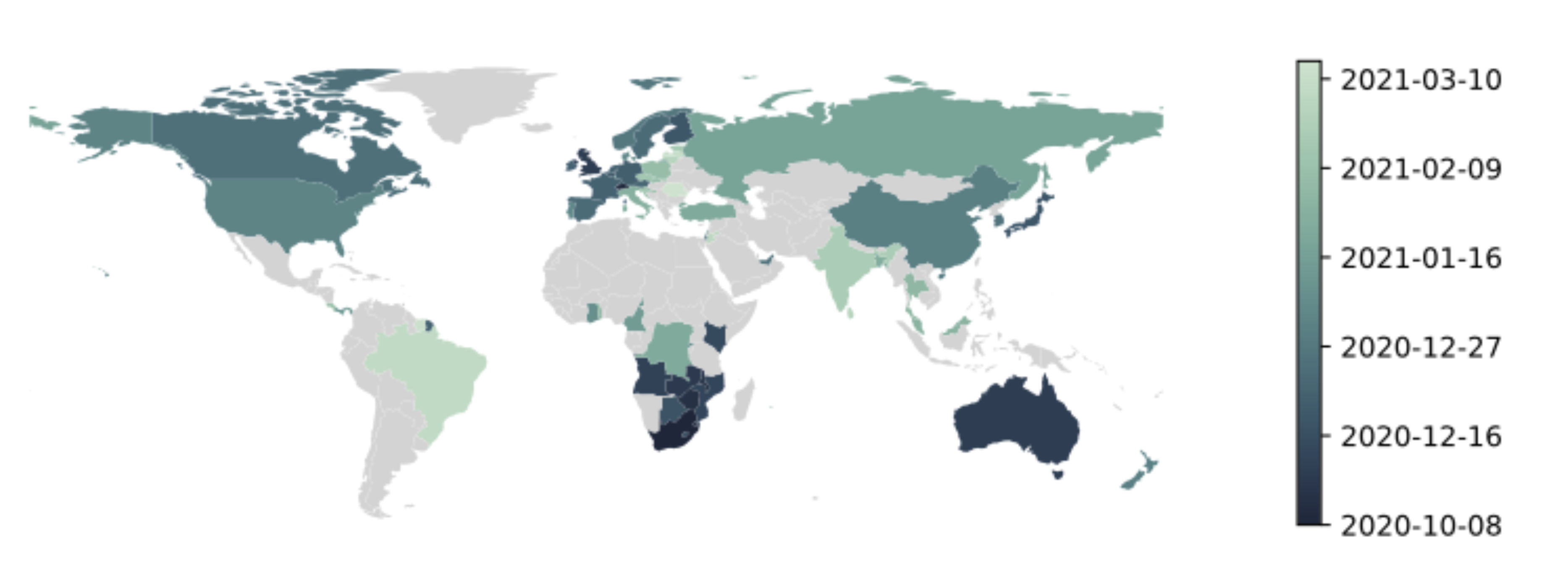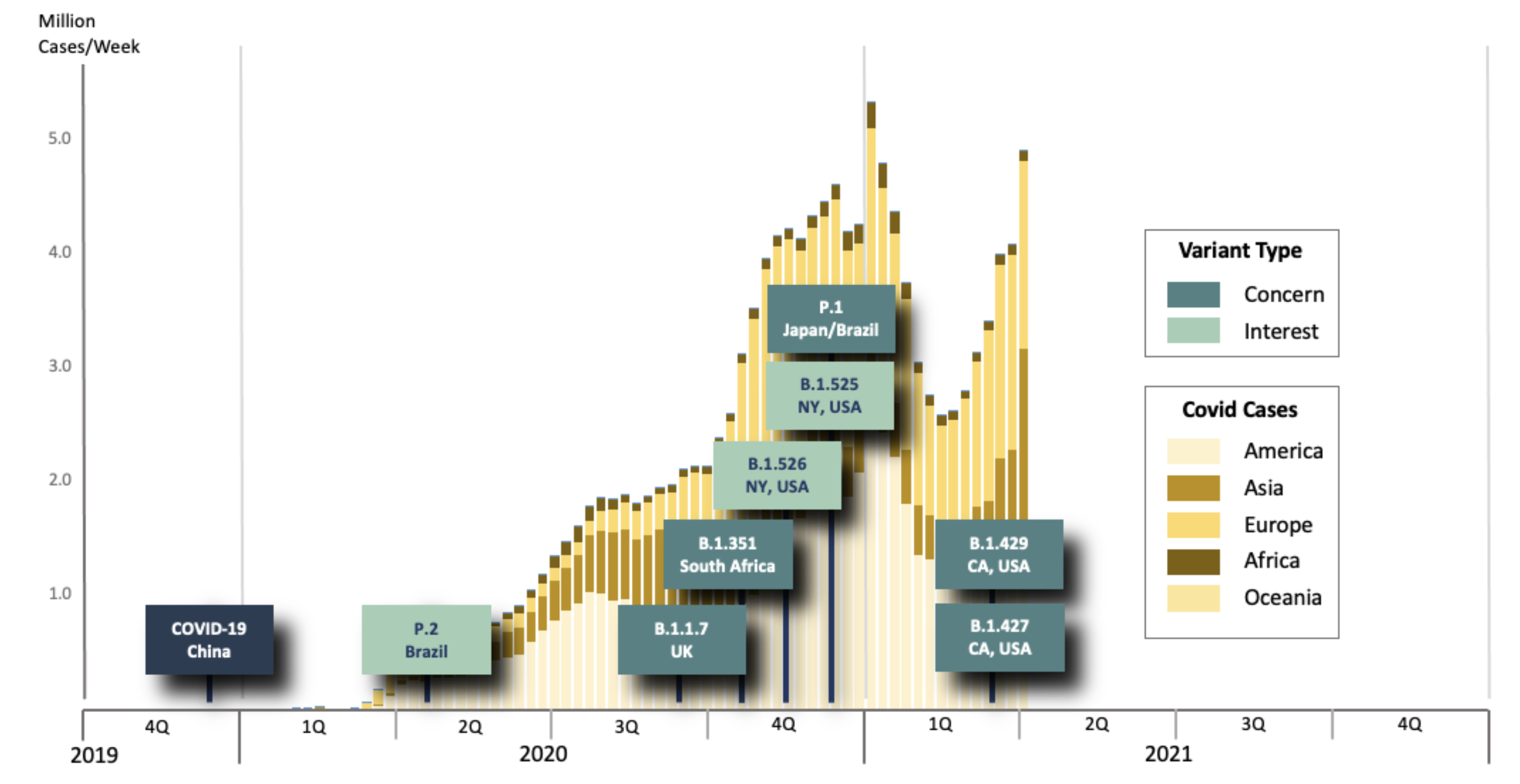Competing Against COVID Variants
Posted by | Michael Ratcliffe
Although we are beginning to shift out of a PANDEMIC world, we now have to plan for the next phase … a HYBRID world. A world that considers the risk of emerging variants while vaccinations are being deployed globally.
Variants
Back in September of 2020, more than 90,000 mutations of the COVID virus had been recognized. A significant concern has become the source for these mutations … the spike protein. The spike protein directly impacts just how lethal the virus is.
Variants emerge when groups of mutations become more prevalent. Today, over 200 variants are circulating in the world. The U.S.’s CDC classifies them by four levels of concern based on its transmissibility, disease severity, and ability of current vaccines to neutralize them:
- Variant Not of Interest – the vast majority (~200)
- Variant of Interest – 3
- Variant of Concern – 5
- Variant of High Consequence – none
Fortunately, there are no existing variants that are of “high consequence”. If higher consequence variants existed, we would be looking at a return to national lockdowns.
Variants being closely monitored by the CDC and date first identified

Variants’ Global Spread
Looking at the CDC’s five “Variants of Concern”, we see key differences from the original COVID-19 strain from Wuhan, China, known as Wild Type. The UK variant, B.1.1.7, has spread around virtually the whole of the world except for areas in Africa and Central America. It is 50% more transmissible than Wild Type, likely to increase hospitalizations and fatalities, but the current vaccines seem to work well against it. The South African variant, B.1.351, on the other hand, has also spread around the world, is also 50% more transmissible but certain vaccines seem to be less effective against it. Hence, the South African variant needs to be carefully watched.
Just how easily variants can spread can be seen from this map of the South African variant, B.1.351. Within two months of it being first seen in October in South Africa, it spread to Australia and areas of Europe. Within 3 months, it had spread to the USA, and in 5 months, to Brazil and India. That’s fast!
Worldwide spread of South African variant, B.1.351

Certainty and Uncertainty
We can say with reasonable certainty that more variants will continue to emerge until we get the virus under control and it is far from clear when that will happen on a global scale.
As the prevalence of the virus increases, the more likely we are to see variants arise. The chart below plots the Variants of Interest and Concern against the reported cases of COVID around the world. With new variants having the ability to spread globally in a matter of a few months, we can see that we are already having to deal with multiple variants, with the strong probability that more will come.
New variants can have any or all the following characteristics:
- Spread more rapidly
- Cause more severe disease
- Evade detection
- More asymptomatic carriers
- Create vaccine immunity
We can also say with a high degree of uncertainty that we don’t know when these will first appear, or where they will first appear. We also need to be prepared for COVID to be an ongoing seasonal occurrence, however, there is too much uncertainty over the emergence of new variants for this to be said.
Timing of identifying Key New Variants and Total Global COVID Cases by Region of the World

Strategic Takeaways
On a global scale, the current goal of global health officials is to create herd immunity, estimated at 65% to 70% of populations, as quickly as possible in the hope that we can return to a pre-COVID world.
There are already success stories. Israel has successfully vaccinated over 50% of its population and new cases have fallen to zero. It is now trying to isolate itself with strict requirements on vaccination and quarantining of foreign travelers. Another success story is the travel arrangement between Australia and New Zealand, which now allows for unrestricted travel between the two countries.
However, if we look at Chile, which has fully vaccinated over 30% of the population, its clear that the incidence has not decreased, but the prevalence is at an all-time high and steadily increasing. This may be due to the fact that 90% of vaccines used in Chile were CoronaVac from Sinovac in China, and Sinovac does not seem to protect as well against the South African variant. So high vaccination rates may not protect against new variants.
An additional complicating factor is a general fear of being vaccinated, which will make obtaining herd immunity levels much more difficult for some countries including the U.S. Uncertainty regarding variants, percentage of populations vaccinated, and efficacy of different vaccines against variants makes it virtually impossible to predict if and when we can get to global herd immunity.
Until more research on COVID is conducted, including on variants, no one should assume that we will be returning to a 100% pre-COVID world. We all need to plan for a hybrid world — one where, if new virulent virus variants suddenly appear, we can quickly switch from in-person sales forces, company meetings, and conferences to completely virtual.
We all have to have contingency plans ready for a sudden return to COVID restrictions, if needed, for certainly the rest of 2021 and possibly into 2022.
Lessons learned about virtual selling, building flexibility into supply chains, and maintaining strong virtual teams should not be forgotten. These should all be captured and formalized as a “Plan B” that can be quickly activated.
We all have to be prepared for the possibility that the CDC might have to define a new variant as “High Consequence.”
Tags: BioPharma, Digital Transformation, Disruption, Healthcare & Life Sciences, Population Health, Risk Management, Strategic Planning



















